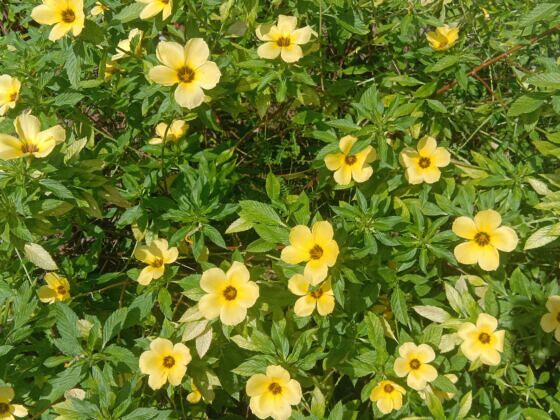My first introduction to damiana liqueur was in La Paz, Mexico, where I received a gift that included damiana liqueur. I was already familiar with other Mexican spirits, such as mezcal and tequila, but the small, souvenir-size bottle piqued my interest. The tag hanging around the neck of the bottle showed a picture of an unruly shrub and stated that the marine air coming from the Sea of Cortez enhanced its flavor. But the more I delved into the history of damiana, the more I learned about its roots — literal, fantastical, and even sexual.


Why You Should Try This Historic Aphrodisiac Liqueur the Next Time You're in Mexico
You may have unknowingly encountered this short, unassuming shrub, scientifically known as turnera diffusa, if you’ve been to southern Texas, Central or South America, or the West Indies. The sandy-rocky soil of the more mountainous regions is ideal for the damiana, which prefers desert areas and bears yellow, five-petaled flowers from January through July.
Typically workers gather damiana right before the cold season by using a sickle to lob off the branches, which are then sectioned and laid out in the sun to dry. They then ready the leaves for collection by stripping them from the stems. It’s a relatively tricky job due to the stony terrain, lack of shade, and possible presence of unwanted critters, such as snakes. Nevertheless, it’s a harvesting process that has remained the same for centuries.
The history of damiana liqueur
The Mayans started using damiana to treat balance issues, but it wasn’t until the late 1600s that some attributed aphrodisiac qualities to the plant. Father Juan Maria de Salvatierra, a Spanish missionary, noted that indigenous Mexicans took the leaves of the damiana and made them into a sweetened tea to help with sexual issues, such as libido and arousal. To encourage fertility and the blessing of children, loved ones gave newlyweds damiana, which is a tradition continued to this day in many families.
When damiana was finally imported to the U.S. in the late 1800s as a tincture in 2-ounce bottles, it came with mighty claims that it could cure the most intimate issues, no matter someone’s age.
What is the herb damiana good for?
As damiana crossed the border, so did folklore. Tales of aged Mexican men siring dozens of children due to the damiana plant circulated. However, for North Americans, the results were mixed. Some people experienced the seductive impact, while others encountered the exact opposite. An 1875 study reported by John M. Maisch noted that most men felt nothing beyond “a slight stimulation from the alcohol,” with one gentleman saying he had “no desire at all for sexual congress” after consuming two bottles.
Beyond being an aphrodisiac, some people also claimed that damiana could heal the urinary and reproductive systems and their accompanying organs. To this day, damiana is sold in many forms to help with menstruation, impotence, and bladder infections. Although, if you decide to make it a part of your regular regimen, do so cautiously, as it can alter blood sugar levels and cause hallucinations if you take more than 200 grams.
Rebecca Story Alvarez is a sexologist on the more positive side of the fence. As the co-founder of Bloomi, a collection of plant-based sexual wellness products, she dove into her Mexican heritage and uses damiana in her line.
“It’s an uplifting herb that naturally boosts arousal in the body,” says Alvarez. “It can be sensual as well, creating a calming, arousing feeling.”
More modern science supports this fact, at least among rats: A 2009 study concluded that damiana helped males recover from sexual exhaustion.
How to use damiana liqueur
As the ancient Mayans did, you can brew tea using damiana leaves or by making a blend with complementary herbs like chamomile and rosehips. Some folks go so far as to smoke damiana, which produces a mild euphoria with calming effects. Note: Healthline strongly advises against smoking the plant.
However, if you’re anything like me, the best way to consume damiana is via a liqueur, either taken neat, over ice, or blended into a cocktail.
What flavor is Damiana liqueur?
The spirit itself is sweet and slightly creamy, making it easy to drink on its own. In Mexico, damiana liqueur often replaces Triple Sec or simple syrup in mixed drinks, such as margaritas. Personally, I enjoyed my sample size on its own, straight from the bottle, and without an aphrodisiac effect, I might add. The only pleasant feeling I experienced was as the liqueur traversed my tastebuds.
So, is damiana a “herbal hoax,” as Varro E. Tyler claimed in his 1983 pharmaceutical article? He concluded that “in the absence of a cure, desperate people want hope, not facts.” Although humans can support or deny such claims, it’s no fault of the damiana shrub’s lovely, yellow, flower-laden branches.
My advice? Head to La Paz — or somewhere south of Texas — to find out for yourself. Whether you experience a placebo effect or the long-sought-after aphrodisiac impact, one thing remains true: You’ll enjoy tasting one of the lesser-known, easy-drinking, Mexican-produced liqueurs.